Business Communication Essay: Exploring Workplace Diversity Issues
VerifiedAdded on 2023/01/11
|6
|1450
|52
Essay
AI Summary
This essay, written for a Business Communication course, delves into the multifaceted concept of workplace diversity. It begins by defining workforce diversity and highlighting its significance in contemporary organizations. The essay emphasizes the advantages of a diverse workforce, such as enhanced innovation, improved customer service, and increased employee morale, which lead to better business performance. The essay also examines the challenges associated with managing a diverse workforce, including potential communication barriers, cultural stereotypes, and conflicts in working styles. The author concludes by emphasizing the importance of recognizing both the opportunities and the challenges that workplace diversity presents, suggesting that a balanced approach is essential for organizational success. The essay includes references to support the arguments presented.
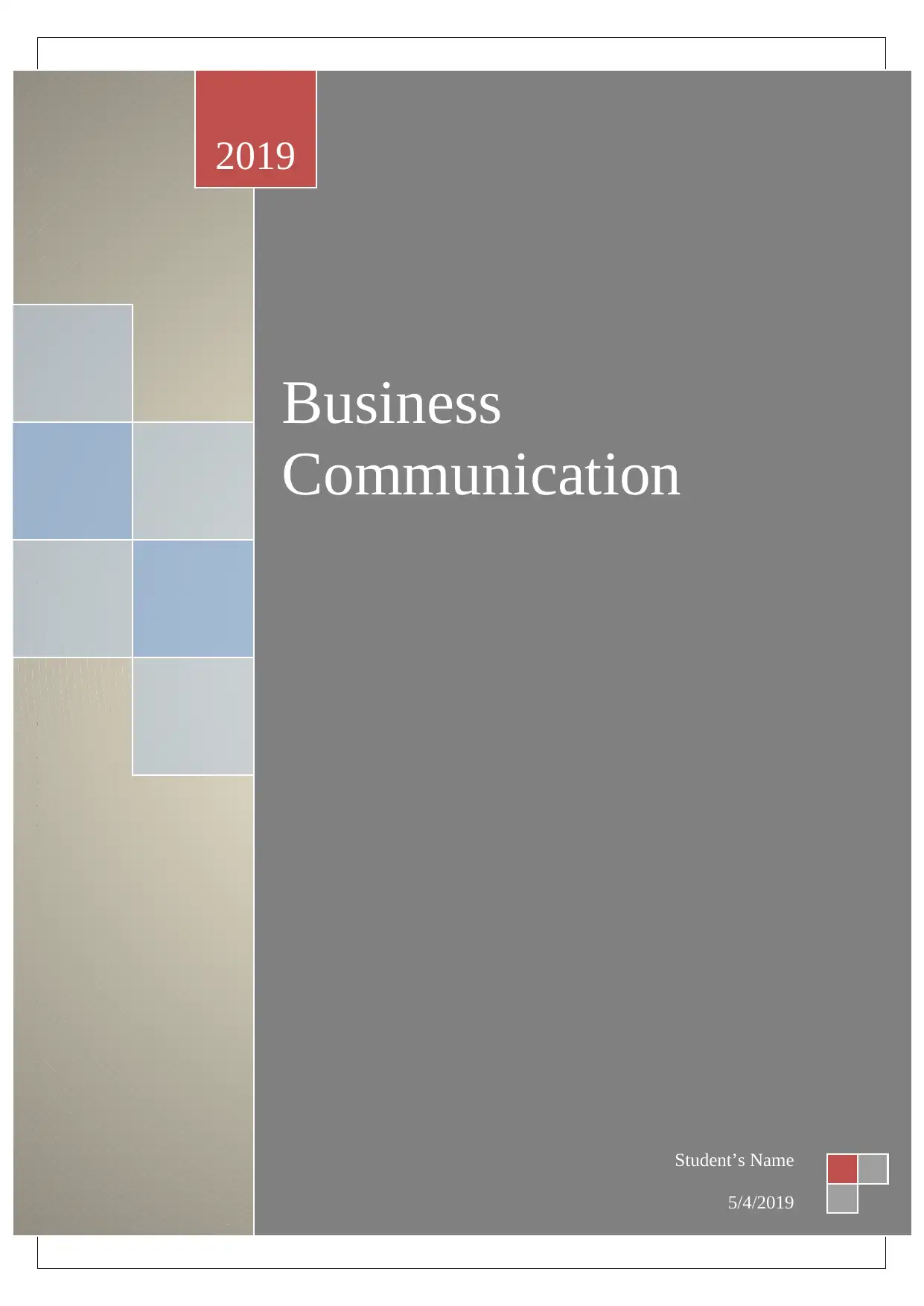
Business
Communication
2019
Student’s Name
5/4/2019
Communication
2019
Student’s Name
5/4/2019
Paraphrase This Document
Need a fresh take? Get an instant paraphrase of this document with our AI Paraphraser
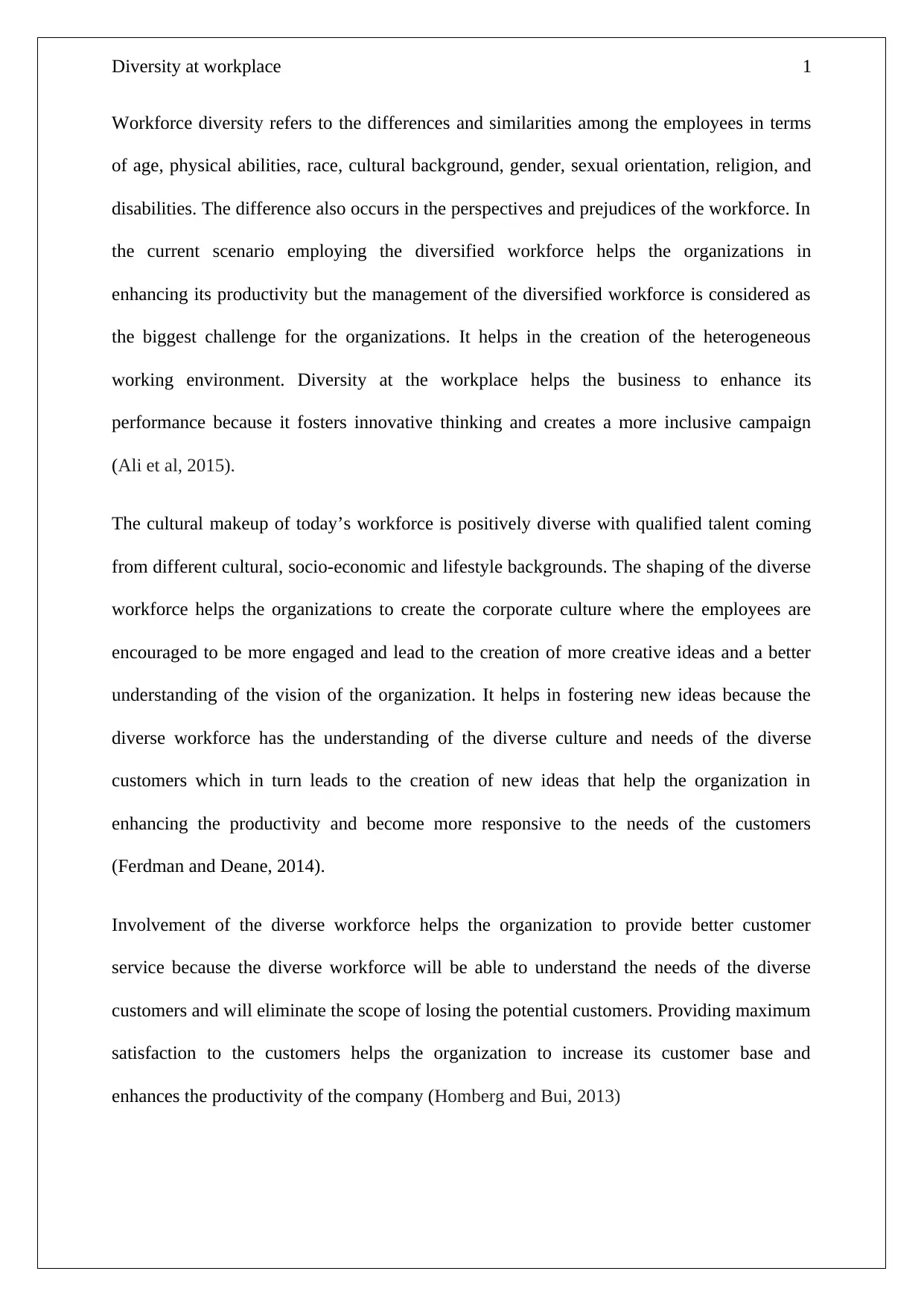
Diversity at workplace 1
Workforce diversity refers to the differences and similarities among the employees in terms
of age, physical abilities, race, cultural background, gender, sexual orientation, religion, and
disabilities. The difference also occurs in the perspectives and prejudices of the workforce. In
the current scenario employing the diversified workforce helps the organizations in
enhancing its productivity but the management of the diversified workforce is considered as
the biggest challenge for the organizations. It helps in the creation of the heterogeneous
working environment. Diversity at the workplace helps the business to enhance its
performance because it fosters innovative thinking and creates a more inclusive campaign
(Ali et al, 2015).
The cultural makeup of today’s workforce is positively diverse with qualified talent coming
from different cultural, socio-economic and lifestyle backgrounds. The shaping of the diverse
workforce helps the organizations to create the corporate culture where the employees are
encouraged to be more engaged and lead to the creation of more creative ideas and a better
understanding of the vision of the organization. It helps in fostering new ideas because the
diverse workforce has the understanding of the diverse culture and needs of the diverse
customers which in turn leads to the creation of new ideas that help the organization in
enhancing the productivity and become more responsive to the needs of the customers
(Ferdman and Deane, 2014).
Involvement of the diverse workforce helps the organization to provide better customer
service because the diverse workforce will be able to understand the needs of the diverse
customers and will eliminate the scope of losing the potential customers. Providing maximum
satisfaction to the customers helps the organization to increase its customer base and
enhances the productivity of the company (Homberg and Bui, 2013)
Workforce diversity refers to the differences and similarities among the employees in terms
of age, physical abilities, race, cultural background, gender, sexual orientation, religion, and
disabilities. The difference also occurs in the perspectives and prejudices of the workforce. In
the current scenario employing the diversified workforce helps the organizations in
enhancing its productivity but the management of the diversified workforce is considered as
the biggest challenge for the organizations. It helps in the creation of the heterogeneous
working environment. Diversity at the workplace helps the business to enhance its
performance because it fosters innovative thinking and creates a more inclusive campaign
(Ali et al, 2015).
The cultural makeup of today’s workforce is positively diverse with qualified talent coming
from different cultural, socio-economic and lifestyle backgrounds. The shaping of the diverse
workforce helps the organizations to create the corporate culture where the employees are
encouraged to be more engaged and lead to the creation of more creative ideas and a better
understanding of the vision of the organization. It helps in fostering new ideas because the
diverse workforce has the understanding of the diverse culture and needs of the diverse
customers which in turn leads to the creation of new ideas that help the organization in
enhancing the productivity and become more responsive to the needs of the customers
(Ferdman and Deane, 2014).
Involvement of the diverse workforce helps the organization to provide better customer
service because the diverse workforce will be able to understand the needs of the diverse
customers and will eliminate the scope of losing the potential customers. Providing maximum
satisfaction to the customers helps the organization to increase its customer base and
enhances the productivity of the company (Homberg and Bui, 2013)
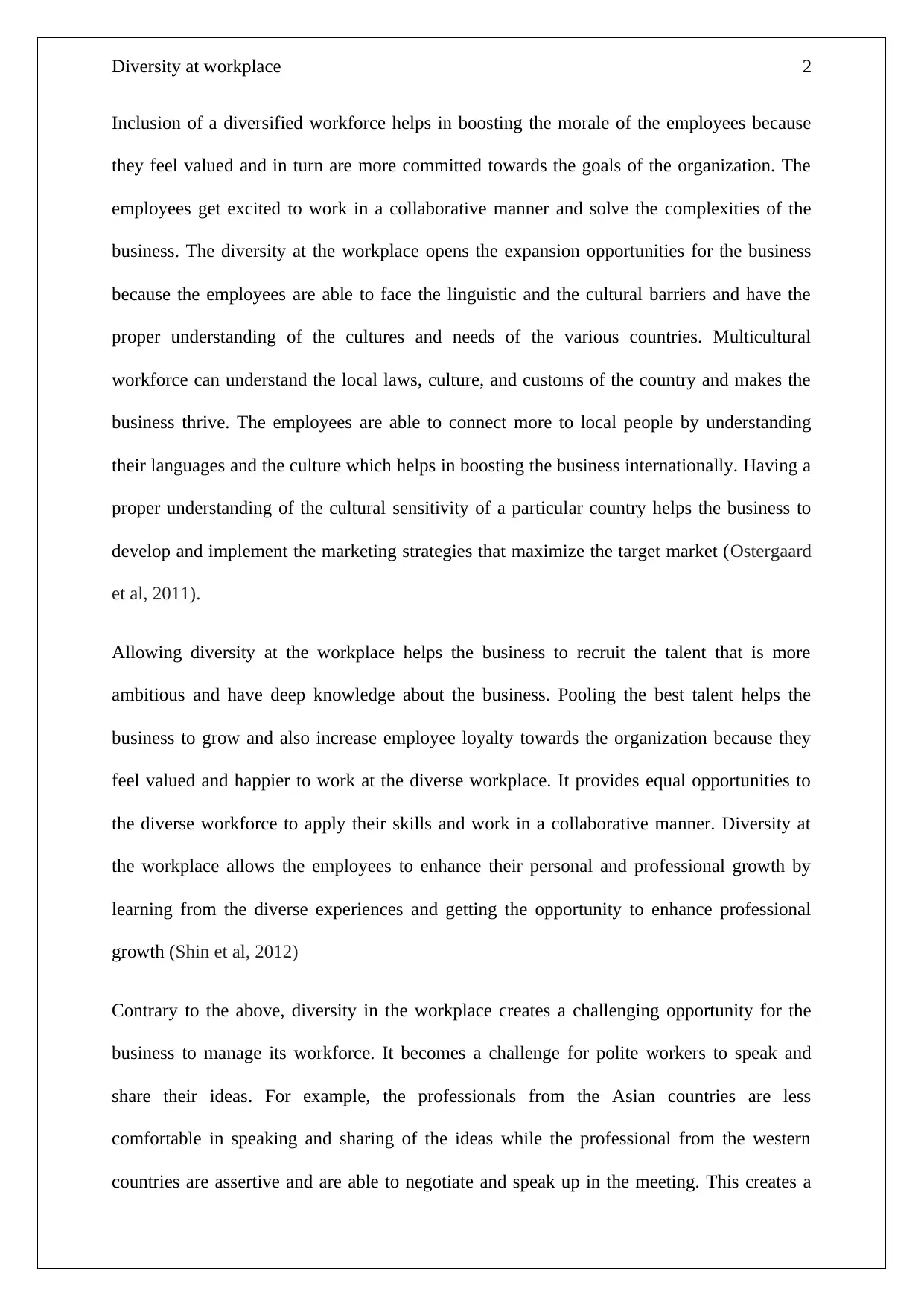
Diversity at workplace 2
Inclusion of a diversified workforce helps in boosting the morale of the employees because
they feel valued and in turn are more committed towards the goals of the organization. The
employees get excited to work in a collaborative manner and solve the complexities of the
business. The diversity at the workplace opens the expansion opportunities for the business
because the employees are able to face the linguistic and the cultural barriers and have the
proper understanding of the cultures and needs of the various countries. Multicultural
workforce can understand the local laws, culture, and customs of the country and makes the
business thrive. The employees are able to connect more to local people by understanding
their languages and the culture which helps in boosting the business internationally. Having a
proper understanding of the cultural sensitivity of a particular country helps the business to
develop and implement the marketing strategies that maximize the target market (Ostergaard
et al, 2011).
Allowing diversity at the workplace helps the business to recruit the talent that is more
ambitious and have deep knowledge about the business. Pooling the best talent helps the
business to grow and also increase employee loyalty towards the organization because they
feel valued and happier to work at the diverse workplace. It provides equal opportunities to
the diverse workforce to apply their skills and work in a collaborative manner. Diversity at
the workplace allows the employees to enhance their personal and professional growth by
learning from the diverse experiences and getting the opportunity to enhance professional
growth (Shin et al, 2012)
Contrary to the above, diversity in the workplace creates a challenging opportunity for the
business to manage its workforce. It becomes a challenge for polite workers to speak and
share their ideas. For example, the professionals from the Asian countries are less
comfortable in speaking and sharing of the ideas while the professional from the western
countries are assertive and are able to negotiate and speak up in the meeting. This creates a
Inclusion of a diversified workforce helps in boosting the morale of the employees because
they feel valued and in turn are more committed towards the goals of the organization. The
employees get excited to work in a collaborative manner and solve the complexities of the
business. The diversity at the workplace opens the expansion opportunities for the business
because the employees are able to face the linguistic and the cultural barriers and have the
proper understanding of the cultures and needs of the various countries. Multicultural
workforce can understand the local laws, culture, and customs of the country and makes the
business thrive. The employees are able to connect more to local people by understanding
their languages and the culture which helps in boosting the business internationally. Having a
proper understanding of the cultural sensitivity of a particular country helps the business to
develop and implement the marketing strategies that maximize the target market (Ostergaard
et al, 2011).
Allowing diversity at the workplace helps the business to recruit the talent that is more
ambitious and have deep knowledge about the business. Pooling the best talent helps the
business to grow and also increase employee loyalty towards the organization because they
feel valued and happier to work at the diverse workplace. It provides equal opportunities to
the diverse workforce to apply their skills and work in a collaborative manner. Diversity at
the workplace allows the employees to enhance their personal and professional growth by
learning from the diverse experiences and getting the opportunity to enhance professional
growth (Shin et al, 2012)
Contrary to the above, diversity in the workplace creates a challenging opportunity for the
business to manage its workforce. It becomes a challenge for polite workers to speak and
share their ideas. For example, the professionals from the Asian countries are less
comfortable in speaking and sharing of the ideas while the professional from the western
countries are assertive and are able to negotiate and speak up in the meeting. This creates a
⊘ This is a preview!⊘
Do you want full access?
Subscribe today to unlock all pages.

Trusted by 1+ million students worldwide
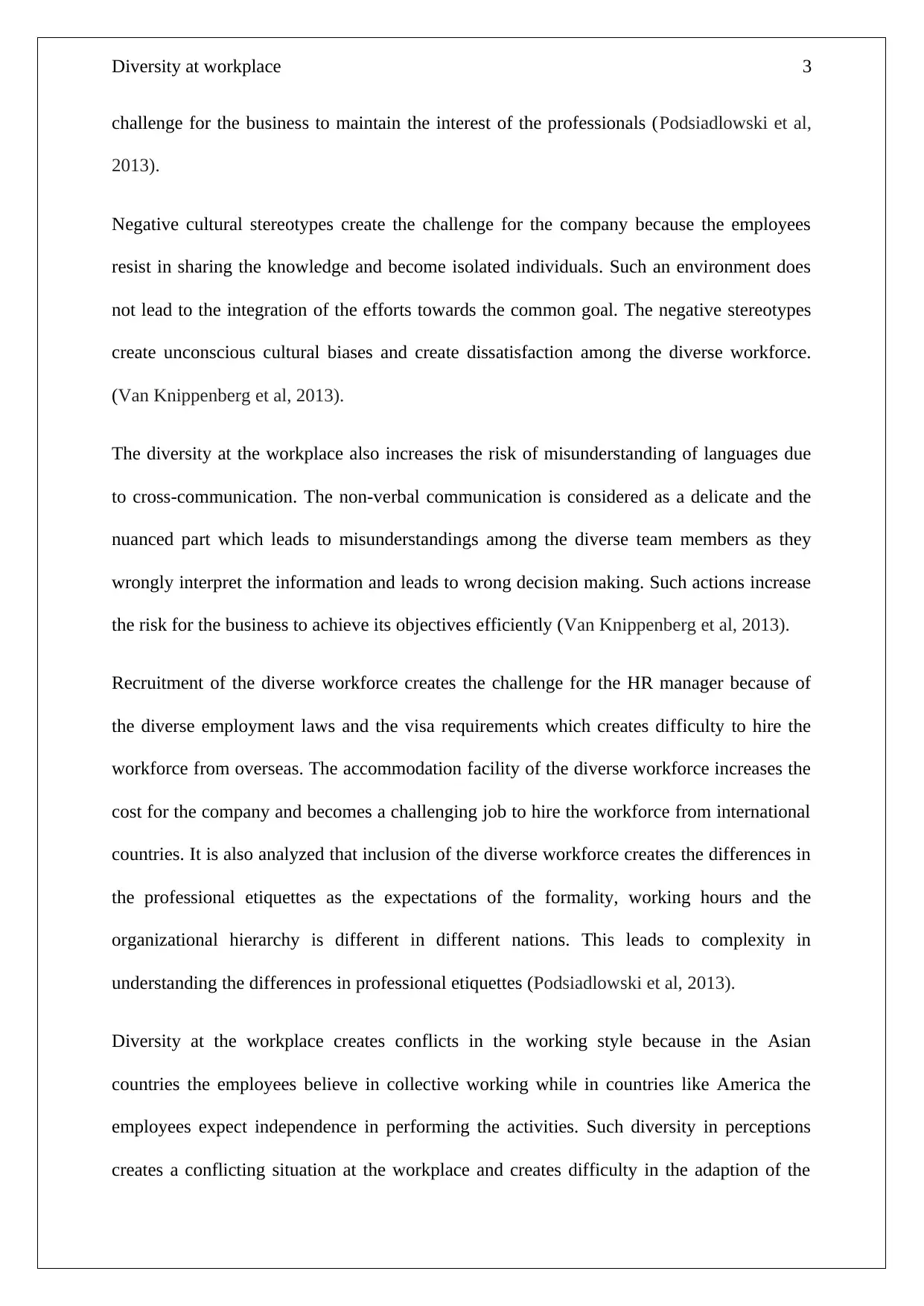
Diversity at workplace 3
challenge for the business to maintain the interest of the professionals (Podsiadlowski et al,
2013).
Negative cultural stereotypes create the challenge for the company because the employees
resist in sharing the knowledge and become isolated individuals. Such an environment does
not lead to the integration of the efforts towards the common goal. The negative stereotypes
create unconscious cultural biases and create dissatisfaction among the diverse workforce.
(Van Knippenberg et al, 2013).
The diversity at the workplace also increases the risk of misunderstanding of languages due
to cross-communication. The non-verbal communication is considered as a delicate and the
nuanced part which leads to misunderstandings among the diverse team members as they
wrongly interpret the information and leads to wrong decision making. Such actions increase
the risk for the business to achieve its objectives efficiently (Van Knippenberg et al, 2013).
Recruitment of the diverse workforce creates the challenge for the HR manager because of
the diverse employment laws and the visa requirements which creates difficulty to hire the
workforce from overseas. The accommodation facility of the diverse workforce increases the
cost for the company and becomes a challenging job to hire the workforce from international
countries. It is also analyzed that inclusion of the diverse workforce creates the differences in
the professional etiquettes as the expectations of the formality, working hours and the
organizational hierarchy is different in different nations. This leads to complexity in
understanding the differences in professional etiquettes (Podsiadlowski et al, 2013).
Diversity at the workplace creates conflicts in the working style because in the Asian
countries the employees believe in collective working while in countries like America the
employees expect independence in performing the activities. Such diversity in perceptions
creates a conflicting situation at the workplace and creates difficulty in the adaption of the
challenge for the business to maintain the interest of the professionals (Podsiadlowski et al,
2013).
Negative cultural stereotypes create the challenge for the company because the employees
resist in sharing the knowledge and become isolated individuals. Such an environment does
not lead to the integration of the efforts towards the common goal. The negative stereotypes
create unconscious cultural biases and create dissatisfaction among the diverse workforce.
(Van Knippenberg et al, 2013).
The diversity at the workplace also increases the risk of misunderstanding of languages due
to cross-communication. The non-verbal communication is considered as a delicate and the
nuanced part which leads to misunderstandings among the diverse team members as they
wrongly interpret the information and leads to wrong decision making. Such actions increase
the risk for the business to achieve its objectives efficiently (Van Knippenberg et al, 2013).
Recruitment of the diverse workforce creates the challenge for the HR manager because of
the diverse employment laws and the visa requirements which creates difficulty to hire the
workforce from overseas. The accommodation facility of the diverse workforce increases the
cost for the company and becomes a challenging job to hire the workforce from international
countries. It is also analyzed that inclusion of the diverse workforce creates the differences in
the professional etiquettes as the expectations of the formality, working hours and the
organizational hierarchy is different in different nations. This leads to complexity in
understanding the differences in professional etiquettes (Podsiadlowski et al, 2013).
Diversity at the workplace creates conflicts in the working style because in the Asian
countries the employees believe in collective working while in countries like America the
employees expect independence in performing the activities. Such diversity in perceptions
creates a conflicting situation at the workplace and creates difficulty in the adaption of the
Paraphrase This Document
Need a fresh take? Get an instant paraphrase of this document with our AI Paraphraser
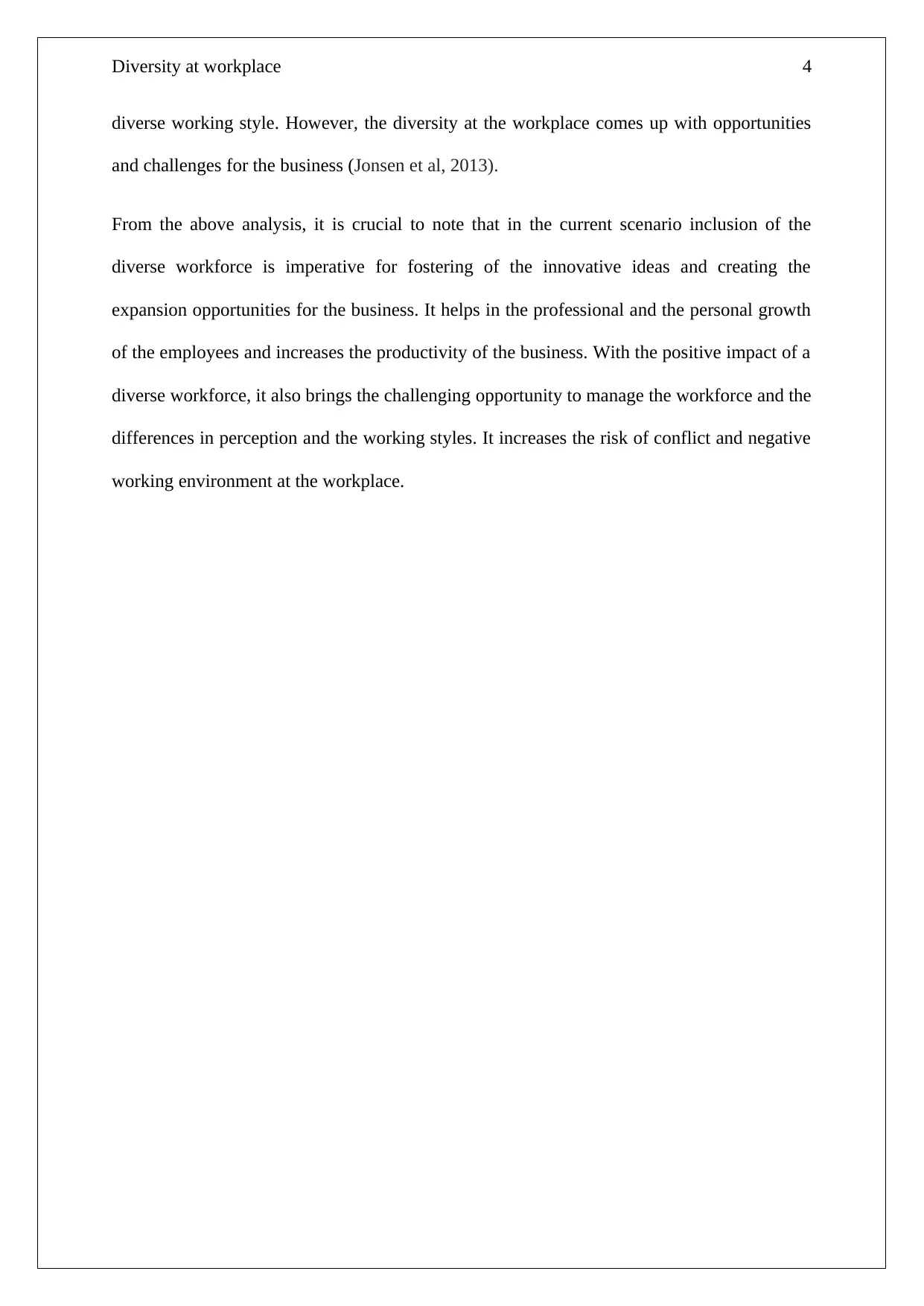
Diversity at workplace 4
diverse working style. However, the diversity at the workplace comes up with opportunities
and challenges for the business (Jonsen et al, 2013).
From the above analysis, it is crucial to note that in the current scenario inclusion of the
diverse workforce is imperative for fostering of the innovative ideas and creating the
expansion opportunities for the business. It helps in the professional and the personal growth
of the employees and increases the productivity of the business. With the positive impact of a
diverse workforce, it also brings the challenging opportunity to manage the workforce and the
differences in perception and the working styles. It increases the risk of conflict and negative
working environment at the workplace.
diverse working style. However, the diversity at the workplace comes up with opportunities
and challenges for the business (Jonsen et al, 2013).
From the above analysis, it is crucial to note that in the current scenario inclusion of the
diverse workforce is imperative for fostering of the innovative ideas and creating the
expansion opportunities for the business. It helps in the professional and the personal growth
of the employees and increases the productivity of the business. With the positive impact of a
diverse workforce, it also brings the challenging opportunity to manage the workforce and the
differences in perception and the working styles. It increases the risk of conflict and negative
working environment at the workplace.
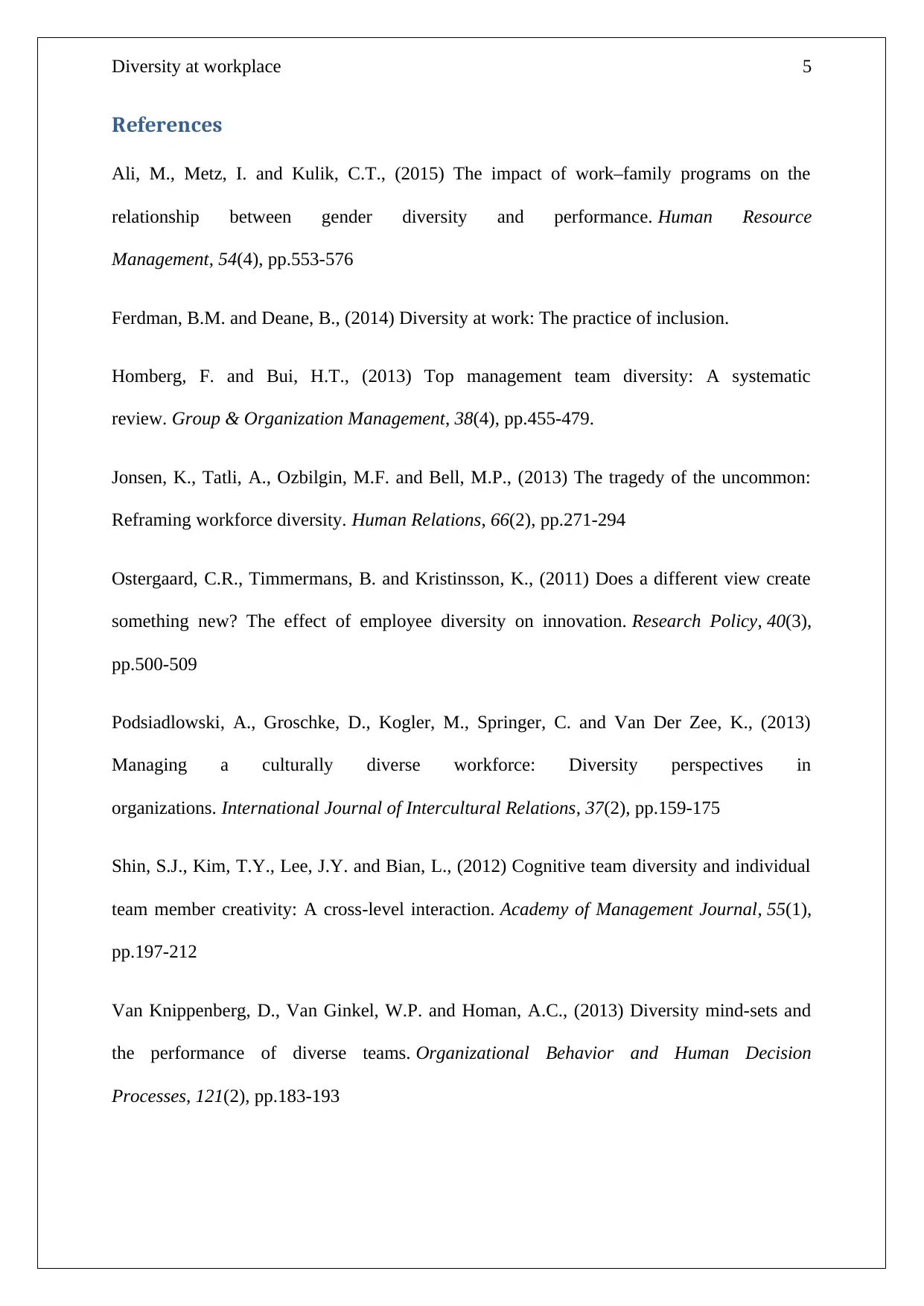
Diversity at workplace 5
References
Ali, M., Metz, I. and Kulik, C.T., (2015) The impact of work–family programs on the
relationship between gender diversity and performance. Human Resource
Management, 54(4), pp.553-576
Ferdman, B.M. and Deane, B., (2014) Diversity at work: The practice of inclusion.
Homberg, F. and Bui, H.T., (2013) Top management team diversity: A systematic
review. Group & Organization Management, 38(4), pp.455-479.
Jonsen, K., Tatli, A., Ozbilgin, M.F. and Bell, M.P., (2013) The tragedy of the uncommon:
Reframing workforce diversity. Human Relations, 66(2), pp.271-294
Ostergaard, C.R., Timmermans, B. and Kristinsson, K., (2011) Does a different view create
something new? The effect of employee diversity on innovation. Research Policy, 40(3),
pp.500-509
Podsiadlowski, A., Groschke, D., Kogler, M., Springer, C. and Van Der Zee, K., (2013)
Managing a culturally diverse workforce: Diversity perspectives in
organizations. International Journal of Intercultural Relations, 37(2), pp.159-175
Shin, S.J., Kim, T.Y., Lee, J.Y. and Bian, L., (2012) Cognitive team diversity and individual
team member creativity: A cross-level interaction. Academy of Management Journal, 55(1),
pp.197-212
Van Knippenberg, D., Van Ginkel, W.P. and Homan, A.C., (2013) Diversity mind-sets and
the performance of diverse teams. Organizational Behavior and Human Decision
Processes, 121(2), pp.183-193
References
Ali, M., Metz, I. and Kulik, C.T., (2015) The impact of work–family programs on the
relationship between gender diversity and performance. Human Resource
Management, 54(4), pp.553-576
Ferdman, B.M. and Deane, B., (2014) Diversity at work: The practice of inclusion.
Homberg, F. and Bui, H.T., (2013) Top management team diversity: A systematic
review. Group & Organization Management, 38(4), pp.455-479.
Jonsen, K., Tatli, A., Ozbilgin, M.F. and Bell, M.P., (2013) The tragedy of the uncommon:
Reframing workforce diversity. Human Relations, 66(2), pp.271-294
Ostergaard, C.R., Timmermans, B. and Kristinsson, K., (2011) Does a different view create
something new? The effect of employee diversity on innovation. Research Policy, 40(3),
pp.500-509
Podsiadlowski, A., Groschke, D., Kogler, M., Springer, C. and Van Der Zee, K., (2013)
Managing a culturally diverse workforce: Diversity perspectives in
organizations. International Journal of Intercultural Relations, 37(2), pp.159-175
Shin, S.J., Kim, T.Y., Lee, J.Y. and Bian, L., (2012) Cognitive team diversity and individual
team member creativity: A cross-level interaction. Academy of Management Journal, 55(1),
pp.197-212
Van Knippenberg, D., Van Ginkel, W.P. and Homan, A.C., (2013) Diversity mind-sets and
the performance of diverse teams. Organizational Behavior and Human Decision
Processes, 121(2), pp.183-193
⊘ This is a preview!⊘
Do you want full access?
Subscribe today to unlock all pages.

Trusted by 1+ million students worldwide
1 out of 6
Related Documents
Your All-in-One AI-Powered Toolkit for Academic Success.
+13062052269
info@desklib.com
Available 24*7 on WhatsApp / Email
![[object Object]](/_next/static/media/star-bottom.7253800d.svg)
Unlock your academic potential
Copyright © 2020–2025 A2Z Services. All Rights Reserved. Developed and managed by ZUCOL.




